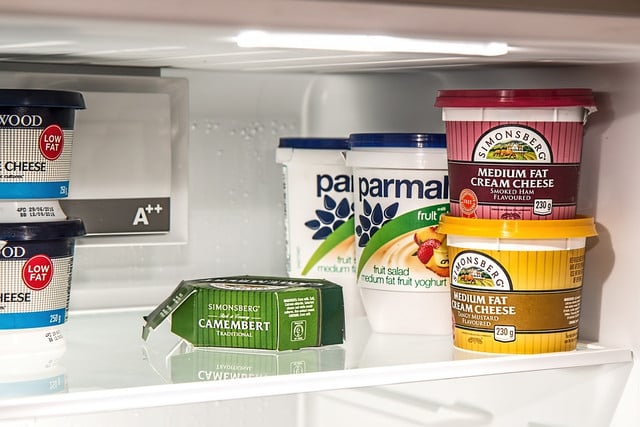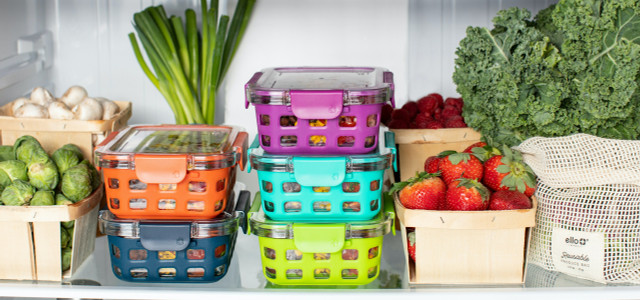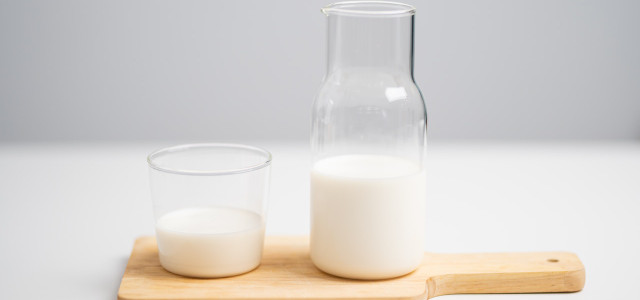Are you looking for the best fridge organization ideas? Do you suspect you need to change your fridge temperature? Fruits, vegetables, and salads are full of important nutrients – but many of them can be lost before they land on your plate. The right refrigerator temperature and organization are crucial and keep your kitchen working smoothly. We show you what temperature a fridge should be and how to optimize your food storage.
Optimal Temperature for Fridge and Freezer
Before you put your new fridge organization ideas into practice, be sure to set it to the right temperature:
- The optimal fridge temperature is 44°F. If your refrigerator has a regulator with settings from 1-6 or 2-7, set the regulator to 1 or 2. This way, your fridge temperature won’t be too cold.
- Rule of thumb: If your butter isn’t spreadable, then the fridge is too cold and should be adjusted to a warmer setting. The optimal temperature for your freezer is 0°F. Running your freezer just one degree colder can cause your freezer to use up to six percent more power — an unnecessary waste of energy.
Important: Regulators with numbers from 1 to 7 do not directly correspond with the temperature. The regulator works within a scale: 1 is the warmest setting, 7 is the coldest.
Fridge Organization Ideas: Where to Place your Groceries

Proper fridge organization plays an important role in reducing food waste and making the most of your kitchen space. If you want your foods to stay fresh longer, you should put them on the correct shelf in your fridge. Many products cannot be stored on certain shelves or in specific bins, others should not be put in the fridge at all.
The air on the top shelves is up to six degrees warmer than on the lower shelves. This is because the cold air drops from the top of the fridge to the bottom – no matter its temperature settings.
Simply follow this refrigerator organization guide:
- Top Shelf, 46°F: Cheese and packaged foods. The top shelf is best for cheese, packaged leftovers and deli meats.
- Middle Shelf, 41°F: Fresh dairy products. The middle shelf is the ideal spot for your dairy products (yogurt, cottage cheese, milk, etc.) It’s also great for opened jars of fruits and vegetables.
- Bottom Shelf, 36°F: Fish and meat. The coldest shelf is where you should store fresh fish and meat. (Remember: Less is more when it comes to animal products, and make sure to buy organic where possible).
- Lower Containers and Bins, 46°F: Fresh fruits and vegetables. Because oxygen, humidity, heat, and light neutralize the vitamins in your fresh produce, the bins at the bottom of your refrigerator are great places to protect your colorful fruits (berries, apricots, cherries, etc.) and vegetables such as lettuce, spinach, mushrooms, carrots, celery, and asparagus.
Ban These Items From Your Fridge
The fridge organization ideas mentioned above will help you keep food fresh for longer. But some foods simply do not belong in the fridge – they will go bad, no matter where you put them:
- Tropical fruits (e.g. pineapples, mangoes, bananas, citrus fruits, etc.) should not be stored in the refrigerator or they will develop brown, watery spots.
- Vegetables with a high water content (cucumbers, bell peppers, zucchini, tomatoes, etc.) lose some of their flavor when stored in cold environments.
- Many root vegetables such as potatoes, garlic, and onions, do not like low temperatures and are likely to sprout if it is too cold for them. It’s better to store them in the cellar or in a dark cupboard.
Check out our guide on Storing Food: 7 Easy Tricks to Avoid Food Waste.
More Fridge Organization Ideas & Temperature Tips



You don’t want your food to lose valuable vitamins or start growing new microorganisms. Take these fridge organization ideas and tricks into consideration to avoid food rot and get the most from the items you buy:
- Put the food into the refrigerator immediately after buying it.
- Don’t overfill the fridge or the air cannot circulate and cool your food properly.
- Place newly purchased products behind others. This makes it easier to use food before it goes bad.
- Store leftovers and fresh foods in glass or porcelain containers with a lid or a plate on top. Your food will stay fresh and flavorful for longer.
- Some fruits and vegetables are sensitive to cold. Store them in a dark room or cellar.
- Only store fruits and vegetables for a short period of time. Even if you store them correctly, they will quickly lose nutrients such as vitamins, minerals and fiber.
- You may have to change your fridge temperature according to the season. Use a lower setting in summer and a higher setting in winter.
- Always make sure that the door is closed properly.
- Defrost your fridge periodically to get rid of frost and ice buildup on the walls, which lowers the cooling effect and uses more energy. Why not empty out and defrost your fridge and freezer the next time you go on holiday? You’ll lower your electric bill and your fridge will work more efficiently.
These fridge organization ideas will help keep food fresh. But did you know that there are foods that never expire?
Read more:
- Healthy Grocery List: 6 Unhealthy Foods to Cross Out
- Storing Apples: Proper Apple Storage Techniques
- Plastic-Free Shopping: 3 Easy Tips for Waste Reduction
This article was translated and adapted from German into English. You can view the original here: Vorräte richtig lagern und die optimale Kühlschrank-Temperatur einstellen.
** Links to retailers marked with ** or underlined orange are partially partner links: If you buy here, you actively support Utopia.org, because we will receive a small part of the sales proceeds. More info.Do you like this post?







